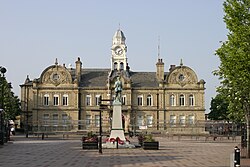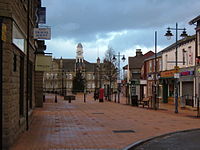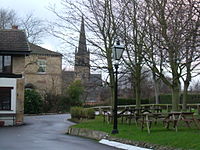Ossett
| Ossett | |
| Yorkshire West Riding | |
|---|---|
 Ossett Town Hall | |
| Location | |
| Grid reference: | SE279205 |
| Location: | 53°40’48"N, 1°34’48"W |
| Data | |
| Population: | 21,076 |
| Post town: | Ossett |
| Postcode: | WF5 |
| Dialling code: | 01924 |
| Local Government | |
| Council: | Wakefield |
| Parliamentary constituency: |
Wakefield |
Ossett is a modest market town within the West Riding of Yorkshire, to be found near junction 40 of the M1 motorway, half-way between Dewsbury, to the west, and Wakefield, to the east.
A pleasant town, at the 2001 census, its recorded population was 20,988 residents plus an extra 88 in communal establishments. Ossett has some of the lowest crime rates in this part of Yorkshire.
Ossett's convenient proximity to the M1 motorway has led the old industrial town to become more affluent in recent years, attracting both industry and resident commuters to Leeds, following on from a period of economic decline that lasted almost three decades.
Name
The name 'Ossett' derives from Old English and is either "Osla's fold " or "Blackbrids' fold".[1]
Ossett is sometimes found written as "Osset".
History
Origins
Ossett appears in the 1086 Domesday Book as "Osleset", which was in the Manor of Wakefield. "Osleset" was recorded as three and a half Carucates which is the land needed to be ploughed by three teams of eight oxen. Woodland pasture measured "half a league long as much broad" (roughly six furlongs by six furlongs). Four villans and three bordars lived in Osleset, a villan was an upper status villager, a bordar was a lower status villager.
Industrial Revolution
Coal-mining was, up to the late 1860s, Ossett's second industry in terms of people employed and the first in terms of males employed. Coal has been mined since the 14th century and there were a large number of pits in Ossett during the 19th century. The pits included Old Roundwood, opened in 1851 mining the Gawthorpe seam. The Haigh Moor seam opened in 1860 and the Silkstone seam opened in 1893. Old Roundwood closed in 1966. Pildacre pit shut due to flooding in 1875 but remained as a source of water for Ossett. Westfield shut in the early 1900s. The Chidswell riot in 1893 was caused by striking miners trying to reach Westfield to stop other miners working. Another pit down Healey Road was also the scene of tension between police and striking miners. Low Laithes pit shut in 1926, however the seams later flooded and were responsible for the Lofthouse Colliery disaster in 1973. Greatfield shut in the 1950s and Shaw Cross, on the Ossett/Dewsbury border near the current Dewsbury Rugby League stadium, closed in 1968.

Author and local resident, Stan Barstow said that Ossett and Horbury were the "border country" where the north-west of the coalfield merged with the southeast of the wool towns. Local historian John Goodchild said, "The place was essentially one of small mines and small mills". The town was once a thriving centre of the "shoddy" industry; recycling woollen garments. Whilst some mill towns employed mostly females in its textile sector, Ossett's mills always had roughly equal numbers of men and women. The town's mills were generally small, but they had a reputation as high-quality producers. Whitehead's Mill used to have a carnival float that said "We Export to the World" at the Gawthorpe May Pole parade.
During the 1970s, Woodhead Manufacturing employed 1,500 people on this site in its two premises fronting Church Street and Kingsway. The shock absorber business was the last part of the site operations to close in the early 1990s. The site is now a housing estate and Woodhead's exists in name only and is run from an industrial estate in Leeds.
Spa
Ossett was, for a brief period in the 19th century, a spa town.[2] Having been founded by a local stonemason who was inspired by Harrogate and Cheltenham, the waters were popular with those seeking relief from certain skin diseases in the early 19th century, but it remained a small spa during this period. In the 1870s, a plan to transform Ossett into a "second Harrogate" ended in failure, and the spa closed as a result. The southeast of the town is still known as "Ossett Spa".
Second World War
In the Second World War, Ossett was bombed on 16 September 1940, possibly in error as to the target.[3] Ten High Explosive bombs were dropped. No one was killed, save for a number of chickens and several properties were damaged. Later in the War, a V-1's engine was reportedly heard to cut out, and came down at Grange Moor, to the west of the town.
Economy

There are four operational textile mills in the town: Ings Mill, on Dale Street, deals in recycled textiles; the Victoria mills on the Green produce carpets; Edward Clay & Son Ltd, Wesley Street manufactures felts for the mattress making and horticultural industries and Wilson Briggs & Son by the River Calder off Healey Road deals with textile mill waste and remnant processing. Other have been converted into units, some of the most prominent being Royd's Mill on the Leeds Road roundabout and the large congregation of mills in the Healey area. Some mills remain derelict.
Ossett is home to two real ale breweries. Ossett Brewery, located in Healey and Bob's Brewing Company, formerly The Red Lion Brewery.
Churches

There are seven churches in the town, each with their own particular identities and initiatives. In the 18th and 19th centuries, the town had a reputation as a centre of Nonconformism.[4] Although Nonconformist churches were common all over the West Riding, Ossett was a particular hotbed. In 1890, seventeen different Christian churches were recorded in Ossett.
Trinity Church is one of the two Church of England churches in the town.[5] The other is Christ Church, South Ossett. St Mary's Church on Dewsbury Road closed in 2002, and its parish was divided between Dewsbury (Chickenley) and Ossett and Gawthorpe (Gawthorpe).
Churches of the town include:
- Church of England:
- Trinity (1865)
- Christ Church
- Salvation Army
- Roman Catholic: St Ignatius (1878)
Sights of the town

Trinity Church was consecrated in 1865 and its spire which rises to 226 feet is a landmark that can be seen for miles around.
A red phone booth in Ossett town centre, opposite the Kingsway roundabout, is a Grade II listed building.
Ossett Town Hall celebrated its centenary in June 2008.
Gawthorpe, an area of north Ossett, is known for its landmark water tower.
Transport links
A Roman road ran from Halifax to Wakefield through here, which route became a turnpike road in 1741, its route is roughly similar to the modern day Dewsbury Road. The M1 motorway between Junctions 40 and 42 to the east of Ossett was opened in April 1967, and the stretch from junction 38 to 40 in October 1968.
The railways arrived in Ossett in 1862 when the Bradford, Wakefield & Leeds Railway company opened a branch line to Flushdyke. The line was extended to Ossett in 1864 and then onto Dewsbury and Batley. Ossett railway station, located roughly where Southdale Gardens now is, was opened in 1889 by the Great Northern Railway. The line ran underneath Station Road and the bump in the road today is the only reminder of the bridge that used to exist there until its removal in the 1980s. The railway station closed in 1964. The town was close to four other railway stations: Chickenley Heath closed in 1911, Earlsheaton in 1953, Flushdyke closed in 1941 and Horbury and Ossett in 1970. It is now the largest town in Yorkshire, and one of the largest towns in Britain, without a railway station. Railway sidings and yards are still to be found at the old Horbury & Ossett railway station site and Healey Mills Marshalling Yard]] where Queen Elizabeth II spent a night aboard the royal train during her 1977 Silver Jubilee tour.
In June 2009, the Association of Train Operating Companies proposed Ossett, as one of seven English towns with a strong business case for the location of a new railway station. It is likely that an unmanned station would be erected at Healey Mills.[6]
Sport
- Rugby: Ossett Rugby
- Rugby League: Ossett Trinity
- Ossett Cricket Club
- Ossett Cricket and Athletic Club
- Football teams
- Ossett Town FC (semi-professional)
- Ossett Albion FC (semi-professional)
- Ossett Wanderers
- Ossett United
- Ossett Panthers
- Little Bull FC
- Ossett Two Brewers
- AFC Two Brewers
The Yorkshire and the Humber branch of the Disability Sports Federation has its headquarters on the Longlands Industrial Estate in the town.
Media
- Newspapers:
- The Ossett Observer, founded in 1864
- The Wakefield Express
- The Dewsbury Reporter
- Free magazines:
- The Ossett Review
- The Ossett Times, published by the Ossett Civic Trust[7]
Events
- The World Coal-Carrying Championships are eld at Ossett (Easter Monday)
- Maypole parade in May.
- Ossett Gala in July.
- Christmas lights, another focal point for the community
- Fire station's bonfire (Friday evening nearest to the 5th of November)
- Ossett Beer Festival (annually at the Brewers' Pride pub) over the August bank holiday weekend.
Wakefield Orchestral Wind is based in Ossett, an orchestral wind band with a varied repertoire including popular film music, show music, big band, classical and their conductor's own arrangements. The band plays regularly at local events, such as Ossett Gala, Horbury Show and Camphill Pennine Community Summer Fair.[8]
In popular culture
- The town is mentioned in the song It's Grim Up North by the KLF.
- Ossett was defined as "wheeare the' black-leead t'tram lines" in both A Yorkshireman's Dictionary by Peter Wright and The Yorkshire Dictionary by Arnold Kellett, although neither book gives any explanation for this. One interpretation is that it was mocking the town's heavy pollution when it was industrialised. Another is that Ossett people were seen as fussy and pedantic.
- From Austin Mitchell's Talkin' Yorkshire (page 48):
In moments of extreme anger Ossett fish-puddlers have been known to resent "thou" and reply "Don't thee thou me thee thou thissen and see how tha likes thee thouing" but this is rare.
- In the "Meaning of Liff", 'Ossett' is defined as a "a frilly spare-toilet-roll-cosy"
Outside links
| ("Wikimedia Commons" has material about Ossett) |
- Wilson, Stephen; "Did the Romans colonise Ossett?"; Ossettcivictrust.co.uk. Retrieved 4 May 2012
References
- ↑ Mills 1998, p. 262
- ↑ Ossett Spa - Little Harrogate detailed local history web site
- ↑ BBC Article
- ↑ Old Towns of England article on Dewsbury
- ↑ Ossett Trinity Church, Ossett Trinity Church, http://www.trinityossett.org.uk, retrieved 2010-03-04
- ↑ (PDF) Connecting Communities: Expanding Access to the Rail Network. Association of Train Operating Companies. p. 9. http://news.bbc.co.uk/1/shared/bsp/hi/pdfs/15_06_09_atoc.pdf. Retrieved 2009-06-15.
- ↑ Ossett Civic Trust
- ↑ Wakefield Orchestral Wind website
- Mills, A.D. (1998), Dictionary of English Place-Names, Oxford, ISBN 0-19-280074-4
- "Bygone Ossett", Norman Ellis, Rickaro Books, November 2003, ISBN 0-9546439-0-9
- "Old Ordnance Survey Maps: Ossett 1890", Alan Godfrey Maps, ISBN 0-85054-237-5
- "The King's England: Yorkshire, West Riding", Arthur Mee
